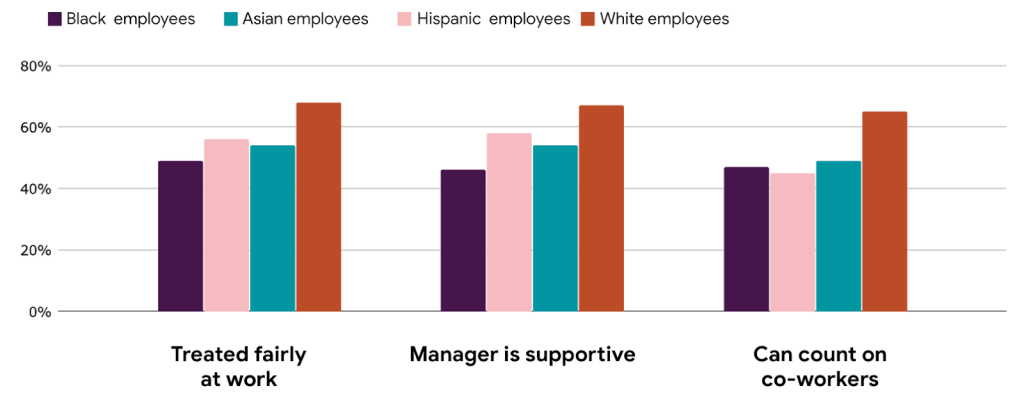
Build team inclusivity and belonging with a few small steps
How leaders can create a culture of belonging within their teams
Posted November 12, 2020 by Sheela Subramanian
Summary and key takeaways
In today’s world, just building a diverse team is just a participation trophy; attention and action needs to extend to retaining world-class talent. This playbook offers executives a few tips for creating more inclusive and equitable organizations.
A few takeaways for leaders:
As a leader, you’ve likely made great strides toward recruiting a diverse workforce that includes a range of ages, genders, ethnicities, religions, and perspectives. You should be proud: you’ve made progress toward the D in D&I, I&D, DEI, DEB, or whichever acronym your organization prefers. But are you finished creating a great workplace? Not quite. Leaders often forget to invest in the E(quity) and B(elonging) part of the conversation.
Most of us know the benefits of fostering a culture of diverse perspectives and experiences. But in today’s world, just building a diverse team is a participation trophy: there’s often not enough dialogue about what’s being done to retain world-class talent. While many organizations may attract diverse employees, are they creating a culture of belonging for women, working parents, veterans, people of color, and others who bring their experiences to the table?
Based on the data, no. According to recent research from the Future Forum,
- Black, Asian, and Hispanic knowledge workers in the United States are far less likely to agree that they are treated fairly at work, they feel supported by their manager, and that they can count on their co-workers relative to their white colleagues.
- Working mothers in the US report that their work life balance, productivity, and satisfaction are all far lower than men with children. And according to recent research from McKinsey and Leanin, 1 in 4 women are considering downshifting their careers or leaving the workforce entirely due to Covid-19. And many are past the consideration phase: women are leaving the workforce at four times the rate of men.

What many leaders don’t realize is that inclusivity is built within the fabric of your team culture; the tone that you set as a leader provides an example for the rest of the team. The act of creating inclusivity can be simplified into a few statements: your talent wants to be treated with respect, be offered a voice in conversation, and operate in a psychologically safe environment to question assumptions without repercussions.
Here are a few ideas that you can actively try out tomorrow.
1. Learn to say the names of your employees
As a person with a “complicated” last name, you’d be surprised how few co-workers have even attempted to say my full name. Not everyone has the last name “Subramanian.” I know people named Andrea, Lara, Keisha, and Jan who have struggled with their names being mispronounced by co-workers and managers. I mean, even our Vice President struggles with this!
Ask your employees how to say their names, practice a few times, and hold yourself accountable. And it’s OK if you ask more than once! Inclusivity starts with respecting your employees and colleagues enough to take the time to learn and say their names correctly. Earn trust by investing the time and humility to get it right.
2. Find ways to help them bring their “whole selves” to work
As stated in the recent McKinsey/LeanIn Women in Work study, “when employees feel like they can bring their whole selves to work, good things happen: They are happier with their job, more optimistic about their company’s commitment to gender and racial equality, and less likely to consider downshifting their career or leaving the workforce.”
Similarly, our recent research on Future Forum showed that non-white employees feel a stronger sense of belonging when they work from home relative to the office and compared to their white colleagues. This data could be attributed to code switching—the act of adjusting one’s behavior or appearance to “fit in” and be treated fairly. The office was a place of exclusion; people are able to bring more of themselves when they work virtually.
You can enable people to bring their whole selves to work by making an attempt at getting to know more about who the “selves” are on your team. Encourage your employees to create a personal user manual. And demonstrate that you’re willing to be vulnerable by creating one yourself. Invest the time to walk through it to understand more about your employees: their motivators, stressors, and what life looks like outside of the Zoom call.
Once you have the conversation, make sure you follow through and show up. Take the time to understand caregiving needs, flexible work arrangements, and how you can empower your talent to feel good about the work they’re doing. And don’t forget to document the conversation and make sure to follow through on any needs they require to do their jobs effectively.
3. Re-think dated tenets of “professionalism”
A few years ago, the Clayman Institute for Gender Research at Stanford analyzed hundreds of performance reviews from four different tech and professional services firms. The results were telling:
- Women were described as “supportive,” “collaborative,” and “helpful” nearly twice as often as men
- Women’s reviews had more than twice the references to team accomplishments, rather than individual achievements
- Men also received three times as much feedback linked to a specific business outcome
The impact of these performance reviews extend beyond the 1/1. When women ask for pay raises or promotions, they often experience backlash or punishment. It’s a destructive cycle.
Leadership is about providing a vision and a path for outcomes for your team members. We need to recognize that we all hold unconscious biases or judgments about people based on gender, race, or other factors without realizing that we’re doing it. Whether providing real-time feedback or writing a review, ask yourself whether you’ve focused on skills and outcomes, rather than prevailing norms of how work should be done or how employees should act.
A few simple things you can change today: celebrate individual achievements by focusing on the business impact, focus on outcomes when giving feedback, and be cognizant of the types of words you use to promote what’s important on your team.
4. Provide “jump balls” for all of your talent
With our teams “sleeping at the office” these days, most are on the fast track for burnout. Between life and work, employees are fueling themselves with guilt and stress.
As you plan for the coming year, start thinking about converting burnout into motivation. Burnout is often cured when employees are excited about their work and have the agency to deliver on it. Provide more “jump balls” for your employees: “Here’s an interesting opportunity, who wants it?” Make sure that you offer them equitably across your organization; if you find opportunities that may be perfect for someone who would otherwise not volunteer, proactively reach out and offer it to them. It’s a great way to link the personal user manual to a new, exciting challenge to drive both personal and professional growth for all members of your team.
5. Bring your team members in
Small talk is a fun way to add lightness to your team meetings and check-ins. But in the absence of in-person interactions, often the loudest speakers dominate the conversation. Conversations often land on “exclusive” topics like summer homes, high-end restaurants, or inside-jokes that only include those in “the know.”
As a leader, it’s your responsibility to be aware of these interactions. No, you don’t need to kill the fun or the laughter. But link the conversations to your team values. Ask questions that all can answer. Be aware of the frequent talkers and try to pull in those who tend to be quieter in group settings. And create a culture of psychological safety so that people are comfortable disagreeing and have paths to do so.
Remember that inclusion means ensuring that everyone’s voices are heard, opinions are considered, and value to the team is evident. Just being listened to is important to people, as is being able to voice ideas and concerns in a safe place.
Building inclusivity as a leader is about listening, but it’s also about authenticity: it’s about how you show up. Don’t be afraid to ask “dumb” questions, admit when you fail, and apologize. It sets a great example to do the same for your broader organization—and will help you not just retain, but motivate and inspire your talent to do the best work of their lives.

